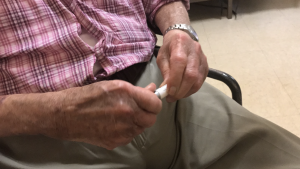Test #1– 4/6/2018
This Friday, we visited Clarewood House Retirement Community. We were able to visit 3 of the senior citizens that we previously met during our first visit. We brought in three different chapsticks to test our prototypes, , HCW statements, and measure of success. This second visit has allowed us to gain a better insights and reshape aspects of our project.
Test #1- Color Test
Previously, we were unsure whether poor eyesight inhibited their ability to operate the chapstick. We assumed that most struggled to a certain degree due to their eye ability. However, to validate our assumption, we prepared two identical chapsticks but one had a distinctive cap compared to the rest of the chapstick (fig. 1) while the other didn’t (fig. 2).
Test #2- Prototype Test
We created a medium fidelity prototype that utilized the finger hold mechanism and a twisting bottom stick using zipties and hot glue. The prototype was presented to the user, but all users failed to identify the usage of the add-on, and, instead, tried to operate the chapstick using traditional movements of pinching the cap to remove it. However, after explaining to the user how the design was intended to be executed, they easily operated the chapstick. We asked the users to rank the level of ease between the three chapsticks. We also noted our own observations of how efficient the users were at opening the different chapsticks. Overall, the collection of our results agreed that the add-on has facilitated the process of using chapsticks.
3-4 Key Insights
Our design was not intuitive. The users easily resorted to their traditional way of using a chapstick. However, after an explanation by one of our team members, the users were all surprised by the convenience of our design.
Having a contrasting color for the cap versus the body can help facilitate the process of using a chapstick. 2 out of the 3 users struggled with the chapstick that was all white. They could not identify the separation of the chapstick cap and body.
Our medium fidelity prototype is functional but hard to observe. The medium fidelity prototype is made out of zipties and hot glue, so, naturally, it may be hard for them to identify the purpose and the zipties themselves. A high fidelity prototype will need to include a very obvious way of involving user to use their finger to pull off the cab. The cab and the bottom add ons will also be noticeable due to size and shape.
Our cap design actually helped achieve one of our goals of not having the cap fall away from users. Users loop their finger through the cap and tightly secure the cap when dispensing the chapstick. When they were finished, they easily guided the gap and reapplied the cap on the chapstick at ease.
HCW Statement
Our HCW statement remains the same: HCW enable arthritis patients to autonomously open, dispense, and apply lip balm on a daily basis?
This trip has reminded us the importance of being able use our design to operate the chapstick autonomously.
Updated Measure of Success
Our initial measure of success included..
- Unassisted successful uncapping and dispensing of container
- Aforementioned actions are always repeated 5 times in succession
- Cap does not fall away from user
- Intuitive
After this trip, we still want to keep these measure of success. However, because of the conditions of most residents are Clarewood, we will be lowering the repeat requirement to 3 times. To test whether the design was intuitive, we observed to see if they used our design the way we intended it to be.
Next Steps
Our next step would be to create a high fidelity prototype that we can use to gauge more specific feedback. We plan on making the cap design more obvious, so users are not confused or accidentally not spot our medium fidelity prototype. Having a higher fidelity prototype can allow us to gain a better insight into our project and develop a final product that can assist people with Arthritis.


